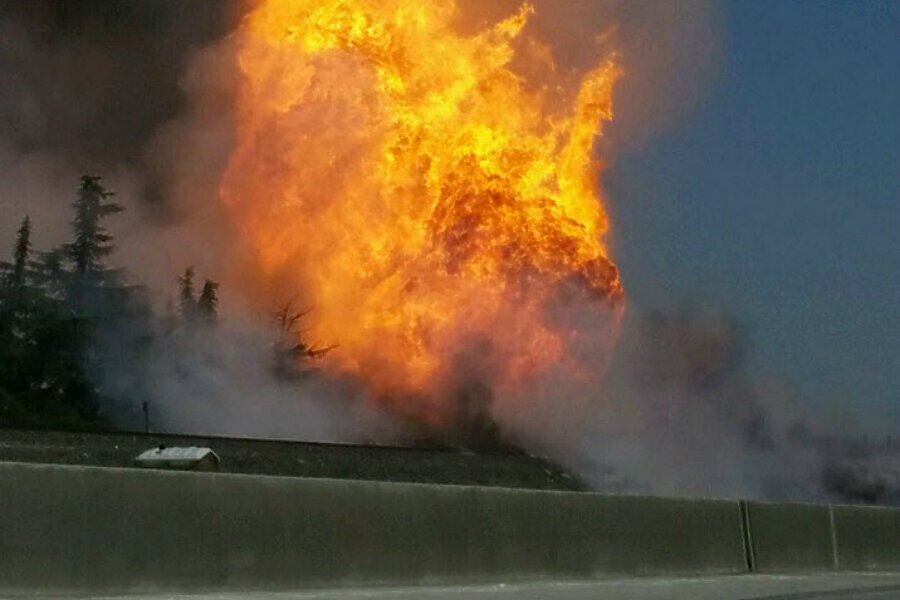Another PG&E pipeline explosion: What was learned from the 2010 explosion?
Loading...
A Friday afternoon pipeline explosion at the Fresno County Sheriff gun range left 11 people injured and caused a massive traffic jam on the nearby state Highway 99, according to the Associated Press.
The pipeline is owned by Pacific Gas & Electric Co (PG&E) and may prompt new questions about California natural gas pipeline safety.
Friday's explosion occurred around 2:30 p.m. local time while a worker was using a front-loader to build up a dirt bern behind the shooting targets. A county worker operating the front-loader and 10 county inmates, who were nearby doing clean-up work, were taken to area hospitals for treatment of burn-related injuries.
"As I got closer, the flames were just bigger and bigger," freelance photographer Kevin Ling told the Associated Press. "It was shooting up to 200 feet or more, and a fireball maybe 10 to 15 feet in diameter. It was like out of a movie."
Both sides of Route 99 were shut down for three hours, as firefighters worked for more than 90 minutes to quell the flames, according to the report. Fresno County Sheriff Margaret Mims told the AP that PG&E had marked the location of gas lines in the construction zones on the range. PG&E spokesman Denny Boyles attributed the explosion to vehicle damage on the pipe, but could not report on how deep the line was buried.
This was not PG&E's biggest pipeline rupture to date. In 2010, a pipeline explosion in the San Francisco suburb of San Bruno killed eight people. Back then, poor oversight and decades of neglect on a pipeline that was installed in 1956 was blamed for the explosion that leveled more than three dozen homes, SF Gate reported.
The National Transportation Safety Board's (NTSB) review of the 2010 explosion also criticized PG&E because the company did not shut off gas to the ruptured pipe until 90 minutes after the explosion occurred. The NTSB also chided state regulators for not keeping better tabs on the utility. PG&E records showed the pipe as smooth and unwelded, but the NTSB found in reality the 60-year-old, 30-inch diameter pipe was held to together with a patchwork of welding jobs.
The explosion occurred when a stress test of sorts was being conducted on a series of pipes welded together by what the industry refers to as "pups" and a weld-flaw ruptured causing gas to leak, which ignited. The investigation concluded that the pups were not up to accepted industry standards, and recommended the company immediately determine their pipeline maximum load capacity through hydrostatic testing, in addition to producing all of their "as-built drawings" to better determine where their older pipes were laid.
In response, PG&E replaced 117 miles of pipeline, on top of upgrading another 201 miles, the San Francisco Examiner reported in November 2014. These safety measures were implemented as the company rolled out better leak-detection technology that is now 1,000 times more sensitive than previous methods.
The company noted that Lloyd's Register had audited and certified PG&E as a best-in-class gas-system operator.
In September, the California Public Utilities Commission levied a massive $1.4 billion penalty on the utility company for its role in the 2010 explosion, USA Today reported.
In addition to the state penalties, PG&E still faces 27 federal charges including lying to investigators and violating federal pipeline safety requirements. If convicted, the company could be forced to pay another $1 billion in penalties.
Some San Bruno residents still question how well the utility company has been held accountable, and are skeptical about fixes made to better ensure safety.
"PG&E has still not yet completed the improvements that would give us the confidence and the comfort that something like what happened here ... would be highly likely not to happen somewhere else," Connie Jackson, city manager of San Bruno, told the San Francisco Examiner.








